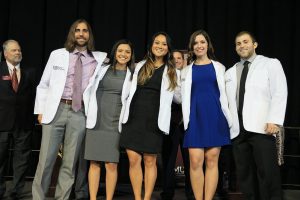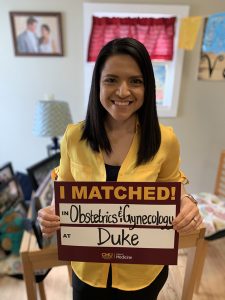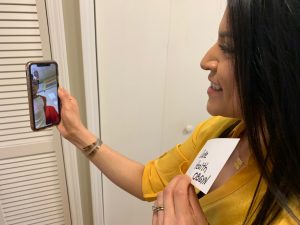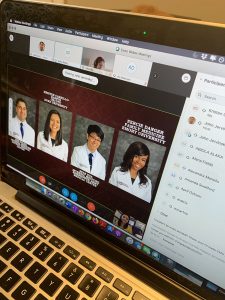Written by Kristen Carrillo-Kappus, Class of 2020 Medical Student
“One word. How did that make you feel?”
In one word, I described my emotional response to completing a simulation training case. Clinical simulation is designed to create an artificial environment mimicking real scenarios for the purpose of training medical students. The scenarios, typically our first experience with each clinical case, ranged from simple blood draws to running a code. During the immediate debrief, our preceptor asked how we felt to provide space for us to express our emotions, allowing us to then discuss our clinical decision-making and actions objectively. We discussed the learning objectives covered in the exercise and later shared our final reflections for future practice.
So, let’s put our learning into practice for our current situation, though not a simulation, but the reality of being a medical student in the time of COVID-19. Although we are all at various stages of our medical education, I represent one perspective of a soon-to-be graduate.
In one word, how does COVID-19 make you feel?
Sad.
Helpless.
Scared.
Anxious.
Furious.
Numb.
While I cannot speak for each of my classmates, I am certain we would provide countless responses. We move through this world with perspectives shaped by our personal experiences, so I understand the reasons we interpret our same world differently. Let’s go back to the beginning when we had our first shared experience. My class started the challenging journey to become a physician at Central Michigan University’s College of Medicine (CMED) on August 1, 2016 with orientation. One word: Eager.
On August 5, 2016, we received our short white coats signaling our readiness to begin medical education and transition to clinical training in our third year. One word: Elated.

If you asked us at the white coat ceremony, I’m certain not a single student in my class would have predicted our journey would end abruptly, eight weeks shy of graduation due to a global pandemic. A pandemic leading to virtual learning for first and second-year medical students, suspension of clinical rotations for third and fourth-year medical students, an unceremonious coveted, now virtual, Match Day and a postponed graduation–but here we are. You are probably wondering which word I choose to describe how this made me feel. I write this today, feeling, one word: Hopeful.
I’ll be honest, though, I did not arrive at hopeful overnight.
For me, awareness of the gravity of the impending pandemic started long before March. Although I am a dedicated medical student, I consider my role in medicine intertwined with the field of public health. I hold a Master’s in Public Health and conducted three years of health disparities and public health research prior to entering medical school. Naturally, my public health lens shapes how I view the world. I periodically monitor public health organizations to reconcile notifications from news outlets about health and disease.
In December 2019, I learned of an Ophthalmologist in Wuhan, Hubei, China who first noticed a new, complicated SARS-like respiratory disease. On January 20th, the United States recorded the first case of the novel coronavirus, now known as the virus that causes COVID-19. The patient was a 35-year-old male in the state of Washington. By January 23rd, the city of Wuhan became the epicenter for COVID-19. On this same day, I read articles on the flight home from my last residency interview. That evening, I finished and submitted my rank order list to the national residency match program (“NRMP”). My husband and I were excited I reached this important step of applying to residency. Like most fourth-year medical students, I started counting the days to March 20th, Match Day (57 days if you were wondering). One word: Anxious.
But this was only the beginning…
On February 7th, while on the family medicine inpatient service, our mid-size suburban hospital was pushed to the brink, preparing for a possible case of COVID-19 based on recent travel history. Airborne precautions were implemented, a negative pressure room was prepared, and we began rationing limited personal protective equipment (PPE). At safety briefings, hospitalists reported reaching capacity due to a heavy influenza season, so we expanded our census to provide relief from the influx of chronic and infectious disease admissions. It was apparent that PPE and capacity issues experienced at our local hospital were only a sign of greater problems to come. One word: Concerned.
Fast forward through the rest of February when Italy became the overwhelmed epicenter of the pandemic. My brother-in-law, a physician, told me fourth-year Italian medical students graduated early to expand frontline capacity. I also learned infectious disease specialists at the time predicted 1 in 6 Americans would be infected by the virus in the United States. I listened to the grave warning while packing to attend a national conference in St. Louis, Missouri. One word: Reluctant.
Reluctant, though I continued on as usual.
While at the airport, I noticed the terminal felt less crowded than during the residency interview trail. During the early days of COVID-19 testing in the U.S., the number of confirmed cases grew by the hour. On day two of my conference, there were just over 100 U.S. cases at breakfast. By dinner, there were over 600. At this point, I knew the rollout of testing was too little, too late. On my return flight, there were even fewer people on the flight than before, and available middle seats were no longer a rarity, but nearly the standard. Were flight attendants told to separate passengers for comfort or as a precaution? One word: Apprehensive.
When I returned, it was 10 days to Match Day. I started my second to last 2-week rotation in radiology. The social media hashtag, #FlattenTheCurve, was trending when we received an email from Dean Kikano. The email informed us the Match Day ceremony would be replaced by a small gathering of just fourth-year students, no family or guests. The next day, the smaller event was canceled entirely to comply with local recommendations. Social and physical distancing started to become the norm. A wave of similar news spread to graduating medical students all across the nation. As I mentioned earlier, we each process news differently.
My class expressed a wide spectrum of emotions. Some of my classmates were sad and even angry. I was in the indifferent camp. I guess I resigned myself to the new socially distant reality before mitigation efforts began. Another part of me (probably the public-health part) knew collectively we would get through the initial disappointment once we arrived in solidarity to acknowledge the greater need. As cases mounted, hospitals began to feel the pressure, doctors and nurses were reaching emotional capacity, while Intensive Care Units were nearing admission capacity, and of course, patients were dying. I felt, more than ever, we needed to step fully into the oath we committed to and do no harm. COVID-19 was doing enough of that for us.
Monday, March 16, 2020 – Match week arrived!
10:53AM, our associate dean for clinical education and emergency medicine physician, notified us that clinical rotations were effectively suspended until April 5th.
10:55AM, I opened the email I had been waiting for what felt like eternity, and read: “Congratulations, you have Matched!” One word: Relieved.
I shared my excitement with my attending for the day, finished reviewing abdominal images and thanked him for teaching me (no handshake of course). I sloshed my hands with hospital grade hand sanitizing gel, picked up my backpack, lunchbox, and white coat and walked to my car. I didn’t know this at the time, but March 16, 2020, would be my last day training in a hospital as a medical student.
The day before Match Day, CMU President, Dr. Bob Davies informed us commencement was postponed. One word: Sad.
I was sad not for me, but I was sad for my family and friends in Texas, Ohio, and North Carolina. I began the difficult task of calling to let them know of the change. The phone call home to Texas was exceptionally difficult because I grew up in a family with limited income and opportunity. For them, flying to a medical school graduation was inconceivable. I am a first-generation high school graduate now becoming a doctor. We were ready to share in this achievement together and despite tight budgets, plane tickets were already purchased.
My husband, family and supporters would no longer be able to witness the first time I would be called “doctor,” but COVID-19 didn’t care.
My mentors, faculty, and student affairs administrators who supported me through my journey would not be able to share in hugs of gratitude, but COVID-19 didn’t care.
My classmates and I would not be able to bookend our journey from white coat ceremony to graduation with pictures to last the ages, but COVID-19 didn’t care.
After the dust settled and renditions of the Michigan “Stay Home, Stay Safe” order were signed for multiple states, medical students all across the country came to the unanimous realization of what we were up against, and we started to care for something different. Collectively our concerns shifted from what we should have been doing, to what we could be doing. We came to understand the pomp and circumstance as secondary to what being in medicine means. We may not be asked to do the job today, but we will not be stagnant. Ask any medical student, resident physician, or attending physician. We do not train to be stagnant.
We train to show up.
We train to be present for our patients.
We train to protect and advocate for our communities.
We train to learn what is known.
We train to face the unknown.
We train to be creative in our approach and to never settle for the status quo.
One word: Determined.
Around the time commencement was postponed, my class came together to identify roles to support our local frontline health providers during this unprecedented time. Various student led projects were generated, such as recruiting medical student volunteers to increase telemedicine capacity, providing child care for doctors and nurses, supporting front line providers at drive-up testing sites in Saginaw, and completing contact-tracing phone calls to providers exposed to COVID-19.
I joined the OB/GYN calling team to connect patients to MyChart to expand telemedicine capacity. We may not have been on the frontlines, but we stepped into the phonelines. And that’s what being in medicine is about. Stepping in when and how you are needed, and showing up, even if that means staying home.
For us graduating medical students, we will be entering residency as the class who completed medical education in the age of COVID-19. We will start residency training in the smog of a pandemic permeating every department we matched into. We will, however, be ready for what lies ahead because the reality of COVID-19 has strengthened our resolve to be in this field, to represent this field, and to take on the most authentic identity of what it means to be in medicine. And to always first, do no harm.
I never came back to Match Day because by March 20, 2020, that was not the headline of the day. But guess what, we matched into a spectrum of specialties!
I’m honored to share that my class will graduate students ready for graduate medical training in family medicine, internal medicine, obstetrics and gynecology (my personal favorite), general surgery, emergency medicine, psychiatry, pediatrics, neurology, child neurology, neurological surgery, urology, diagnostic radiology, anesthesiology, orthopedic surgery, pathology, and physical medicine and rehabilitation. We each celebrated in our own small, personal ways at home, connecting with our loved ones and our class virtually.



Ending this post as if we are in clinical simulation training, my final reflection is this: When we set out to begin residency this summer, we will face a new world of medicine shaped by the pandemic. I am confident, though, the class of 2020 will be ready because we, too, are shaped by the pandemic.
How does this make me feel? Hopeful.
